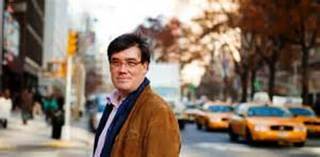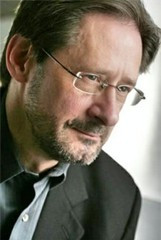|
Back
Codes, Cyphers and Glories New York
David Geffen Hall, Lincoln Cewnter
06/11/2016 -
Per Nørgård: Symphony No. 8 (U.S. Premiere)
Pierre Boulez: Messagesquisse
Steven Stucky: Second Concerto for Orchestra (New York Premiere)
Eric Bartlett, Alexei Yupanqui Gonzales, Patrick Lee, Maria Kitsopoulos, Sumire Kudo, Qiang Tu, Wendy Sutter (Cellos)
New York Philharmonic Orchestra, Alan Gilbert (Conductor)

A. Gilbert (© IMGArtists.com)
“Because we can create, we have anxiety. If there were no possibilities, there would be no anxiety.”
Søren Kierkegaard (1813-1855)
For such a delightful country. Denmark a few renowned anxieties. Their great philosopher, Søren Kierkegaard was a pretty anxious fellow. Another must have been instinctively imagined by Shakespeare with that most anxious Prince of Denmark. And while Carl Nielsen was am optimistic composer, Per Norgaard has been straining to reach the edge of the universe for over eighty years now.
That cosmic challenge was the first of three challenges which Alan Gilbert attempted with last night’s most large-scale New York Biennial climax. Where the other concerts in this most important–even urgent–festival of contemporary music–were daring, challenging and highly adventurous, Maestro Gilbert finished with three of the most substantial composers of the late 20th Century.
And while Manhattan audiences were certainly aware of the name Boulez and Stucky, Per Nørgård is irrationally new to them. Irrational because the Danish composer, while forming no school of his own, has been intensely creative and original. A landmark not only for music of Scandinavia, but the entire European canon.
Admittedly, my first hearing of Per Norgard was his easiest, his most accessible. The choral songs, sung by the Rilke Ensemble, is folkish, tuneful, happily complex, the work of a composer delighted to work. But his symphonies, some burdened with ontological titles, are more difficult. They strain, they reach out, they are not always coalescent but they give the feeling of a great mind at work.
Thus, it was no accident, it was almost imperative that Alan Gilbert offer a fairly extensive “explanation” of the Eighth Symphony last night. Audiences for the other Biennial concerts were pretty savvy. But with the entire Philharmonic in the familiar Lincoln Center hall, some exegesis, barely technical, was important.
Maestro Gilbert did his best, yet on first hearing, this Symphony, musically entrancing, had the a cryptic–dare I say Kierkegaardian?–character. Mr. Gilbert could demonstrate the downward and upward scales, or the military drumbeats or the brass climaxes. Yet these were dots and pointers without links. The only way to understand was to listen. To find the structure.
It was architecture, I suppose. And Nørgård compared the opening to Mesopotamian ziggurats. But architecture is supposedly frozen music, and Mr. Nørgård’s music whirled about in its own space, trying to assume some kind of balance. At times in this opening, it struck a Javanese gamelan music with piano and vibraphone and harps. At other times, Mr. Nørgård was giving a chamber-music quality to a very large orchestra.
Admittedly, whatever architecture–or cosmic plan–he was attempting, I felt only the colors. The vibrancy and glistening sounds, the repeated brass notes at the end, the whispers of instruments painfully trying to become poised.
Obviously a composer of Mr. Nørgård’s genius could balance out whatever he wanted. Yet here, like Kierkegaard attempting to define anxiety, no definitions could do justice to this endeavor in reaching out to the universe.
One would imagine that the most difficult (or at least the muddiest) part of the concert would be Pierre Boulez’ Messagesquisse for solo cello and six other cellos. Mr. Gilbert didn’t bother to “explain” it, since the program notes gave a cryptographer’s account. Briefly, Boulez was paying homage both to the Swiss conductor Paul Sacher, and to the virtuosity of Mstislav Rostropovich. This along with a Morse Code rhythm of Mr. Sacher’s name.
Now...er...the last time I heard Morse Code being tapped out was in John Ford’s Stagecoach. But one could appreciate (I hate the word!!) just what virtuosity Eric Bartlett and his fellow Phil cellists enjoyed here. Less the great composer than the great conductor Boulez never allowed those seven cellos to be anything but light, delightful, scurrying along with avian grace.
Maybe later I’ll study the Morse Code element. But don’t telegraph me. I’ll telegraph you.

S. Stucky (© www.presser.com)
The final work needed no explanation–yet as the (sadly anonymous) program notes showed, the late Steven Stucky loaded his Second Orchestra Concerto with all kinds of arcana.
Those secrets, though, we no more foreboding than Google Easter Eggs. He studded his Concerto with quotes from various composers. Just a few measures, though I could spot the clarinet in the Ravel Piano Concerto and a few notes from Petroushka. Another code–this equivalent to the pictorial notation of the Holy Cross–were “sonic alphabets” spelling the name of Esa-Pekka Salonen, Frank Gehry and other luminaries.
Mr. Stucky must have enjoyed literally spelling these out for his friends, but they made no difference for a work which was simply as thrilling, exciting, vibrant, sparkling and glorious as the Béla Bartók Concerto for Orchestra. Mr. Stucky in his last years gave his orchestra a blazing fire, yet a fire with its own figurations.
He started with a flamboyant Overture (With Friends), then continued with a woodwind theme, and wonderfully inventive sextet of variations, all in contrasting tempos. The finale started with brass fanfares, these intermixed with eccentric groups of instruments, and all with growling chords until the fiercely zesty ending.
Thus ended, with a roar, the Second NY Phil Biennial. And one must wonder whether this is the end of all Biennials. Mr. Gilbert, the Biennial founder and eminence technicolor, will be leaving soon. Audiences were frequently sparse. And while ConcertoNet and the Times tried to review as many concerts as possible, it left New York somewhat cold.
But for those who us privileged to play in, write about, and listen to–these challenging works, one must quote, the Elizabethan poet: “It shall suffice that these notes lived and died for our delight.”
Harry Rolnick
|